Introduction
Loyalty point systems have proven to be a highly valuable asset for traditional businesses. They serve the purpose of rewarding customer behavior, fostering brand loyalty, and overall earn trust for repeat engagement with a product or service. In crypto, points systems have become a central feature for the early onboarding of users, most often during the early stages of protocols right before the actual launch of their token. Not only are they a replacement for liquidity mining programs in the pre-TGE days, but they have also proven to be very helpful for protocols to guide their users and incentivize behavior. This allows projects to reward users who contribute liquidity or volume by performing the most valuable actions for the protocol at any given point of time. These systems also provide flexibility to help guide incentives, adapting to market conditions and focusing on those metrics that the protocol needs most at any given time.
What started as simple traditional reward programs has now evolved into more sophisticated mechanisms that enable projects to align user actions with growth objectives. However, existing secondary markets for points often fail to address the diverse needs of stakeholders. The root of the problem derives from illiquidity, as points are issued off-chain and tracked via centralized APIs.
Rumpel, launched in September 2024, addresses these challenges through a points tokenization protocol that brings liquidity and price discovery to off-chain loyalty points. By allowing points to be tokenized and traded on-chain, Rumpel creates opportunities for users while solving inefficiencies in current systems. For example, farmers of a protocol may accumulate large amounts of points but require liquidity, while newer users who feel late to the narrative might be willing to pay a premium to acquire points from early participants. This creates a natural alignment of incentives and underscores the need for platforms like Rumpel, which matches users with distinct preferences to create a win-win scenario.
This report explores how Rumpel works, its benefits to users, and how it differentiates itself from competitors like Whales, Bubbly, and other pre-launch market platforms. It also highlights a case study about how to get started on the Rumpel App, and how different users can take advantage of its features to come up with their own strategies.
Key Takeaways
- Point Systems in Web3: Loyalty points have traditionally been highly effective tools for driving user engagement and incentivizing behavior. Crypto is now adopting this playbook to enhance price discovery pre-TGE and guide users to perform the most valuable actions for a protocol at any given time.
- Rumpel’s Solution: Rumpel tokenizes off-chain points, turning them into on-chain tradable assets. This results in favorable liquidity conditions that lead to more efficient price discovery on-chain,addressing limitations in existing secondary markets.
- Benefits to Stakeholders: Rumpel enables point farmers to monetize their points, investors to increase exposure efficiently, liquidity providers to earn fees, and issuers to improve their reward programs with greater transparency and flexibility.
- Differentiation from Competitors: Rumpel overcomes the structural constraints of secondary markets like Whales and Bubbly by eliminating collateral requirements, enabling single-point markets, and offering uncapped airdrop payouts.
- Rumpel Growth: Since its launch in mid-September 2024, the platform has partnered with protocols like Ethena and Karak, achieved +$50 million in TVL, listed more than 30 strategies to earn points, and launched its native reward program, Rumpel Straw, to incentivize user participation and ecosystem growth.
Background: Point Systems in Web3
Point systems in crypto have emerged as a defining trend of the current crypto cycle, echoing the fervor of past ICOs but with a distinct twist. Unlike ICOs, where participants paid for tokens (often upfront and before the actual project was built), point systems allow users to earn rewards in exchange for engaging with a project. These rewards compensate users for their support on the early days of a project, retroactively recognizing them for their contributions. This model transforms traditional loyalty systems in a decentralized context, where user engagement becomes a metric for protocol success, and points ultimately evolve into a quantifiable form of speculative currency.
The Role of Points in Web3
Points in crypto function as the Web3 equivalent of credit card rewards. Just as cardholders accumulate points through spending, users earn crypto points by interacting with a protocol—staking, providing liquidity, or participating in governance. However, the perceived value of these points hinges on rules set by the project team, often with the promise of future tokens (airdrops) as compensation. This implicit game of trust creates a delicate balance, as the actual distribution of points is often opaque, and not all rules are presented upfront. On one hand, satisfied users may convert into long-term supporters of the project. On the other hand, discontent over points distribution can lead to abandonment, with users dumping tokens and moving on to other opportunities. Projects need to find a delicate balance to avoid over-allocating points to opportunistic “mercenary farmers” while fairly rewarding those users who are most likely to continue engaging with the protocol for the long term.
The psychology of instant gratification plays a pivotal role in the appeal of these systems. Instant gratification taps into the human desire for immediate rewards, a behavior reinforced by the fast-paced nature of modern life. In the context of crypto, the act of accumulating points satisfies this craving, offering a tangible reward with the speculative allure of future value. While these points often hold no intrinsic value and exist off-chain, their perceived worth arises from the promise of airdrops, which are seen as primary reinforcers. Over time, the accumulation of points becomes an end in itself, with users speculating on their potential value in pre-listing markets like Rumpel, Whales Market, or Bubbly.
For users, these points serve as an innovative form of yield—like liquidity mining but without knowing the actual value of the yield rewards. Beyond the actual returns from staking or liquidity provision, points act as an extra layer of incentives. Unlike tokens, which can be immediately sold on the open market, points offer an element of surprise and speculation, adding to their appeal through gamification and market psychology. This model not only helps projects stand out in competitive markets but also reduces immediate selling pressure, as points are not directly tradable. In essence, they function as a Pool2 farming mechanism without token emissions, creating a more sustainable reward system that can have beneficial spillover marketing effects .
From a project’s perspective, point systems can be an effective mechanism for bootstrapping the initial liquidity and user base. By allocating points as rewards for specific activities projects can influence user behavior. These systems signal to users which actions are most valued, such as supplying liquidity, leveraging funds through looping, or using the platform intensively. This alignment of incentives allows projects to shape user actions in ways that directly support their growth and operational goals.
In addition, point systems expand marketing opportunities, especially when paired with referral programs, by widening the marketing funnel. They also drive growth by lowering the effective price of a product or service, increasing conversion rates and improving KPIs like active user numbers. Furthermore, points improve product stickiness and loyalty, increasing user Life Time Value (LTV) and reducing churn—studies show loyalty members spend 27% more on average. Finally, dynamic point programs are particularly effective in the early stages of products with network effects, rewarding early adopters and improving the user experience to help the product reach critical mass.
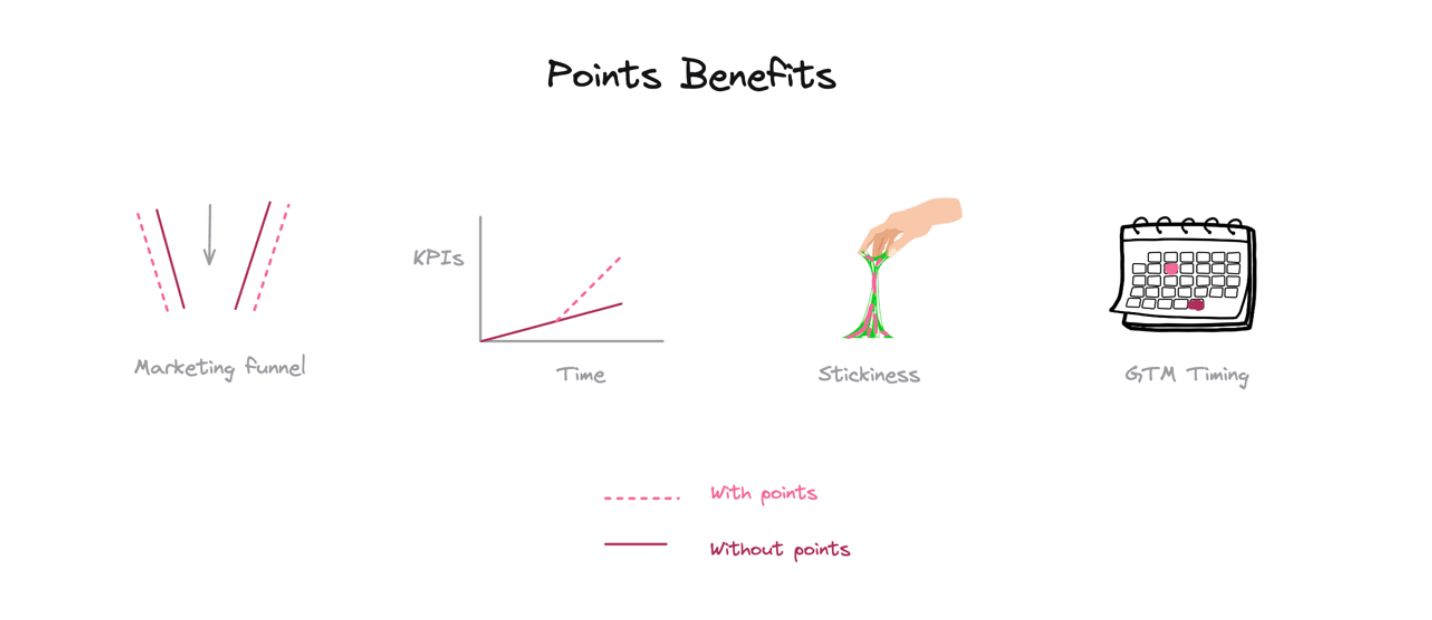
How It All Started
The use of point systems in crypto began to gain traction with Blur in 2022, followed closely by FriendTech and other protocols soon after. Although these early adopters laid the groundwork, it wasn’t until recently that point systems became a widespread trend, with many projects adopting them simultaneously.
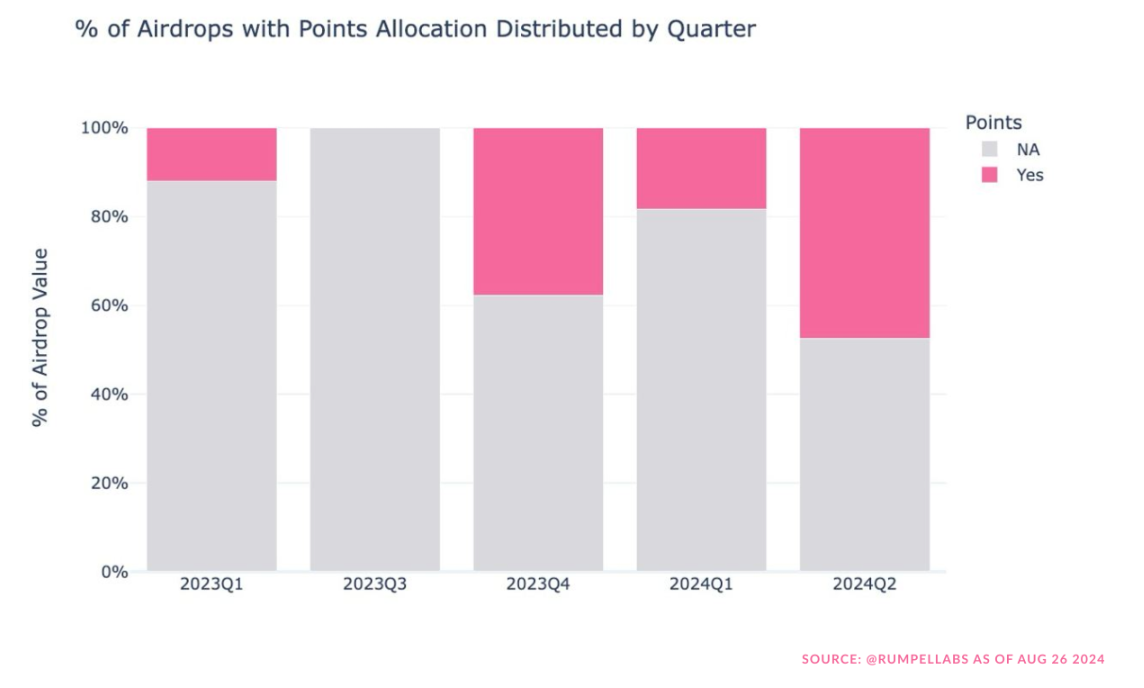
Blur was the first project to successfully leverage a point system to disrupt the status quo in NFT trading. Competing against OpenSea, Blur faced the challenge of convincing users to switch platforms (a form of vampire attack by implying future rewards). While competitors like X2Y2 attempted to incentivize activity with airdrops, these efforts lacked long-term impact, as users realized a profit and abandoned the ecosystem once they got their “free” tokens. Blur’s point system, however, offered a more compelling incentive, as it served the purpose of tracking the value added by users in real time. For instance, users could earn points by bidding and listing NFTs, creating a gamified system that encouraged platform activity. During the first season of points, Blur did not yet surpass OpenSea’s trading volumes, but it managed to improve liquidity conditions, which was critical for the growth rates that would come down the road with follow-up point seasons.
The game changed when $BLUR token rewards were distributed, with some users reportedly receiving six-figure payouts through airdrops. This significant reward created a strong increase in user activity, drawing crowds eager to farm points for Season 2. Blur later introduced Season 3 and expanded its ecosystem with Blast points, making these systems a core part of its retention strategy. Blur’s approach demonstrated the potential of point systems not just for bootstrapping liquidity but also for sustaining user engagement over time and disrupting the incumbent.
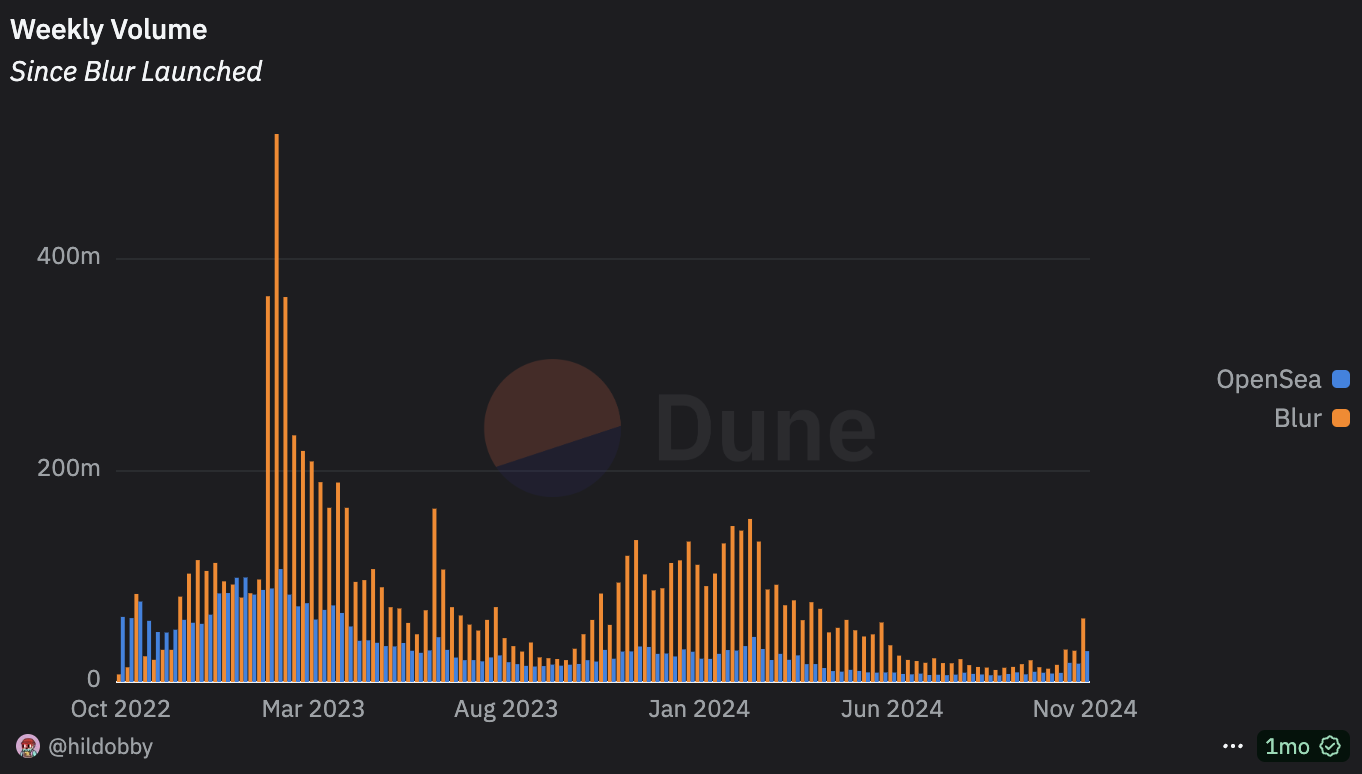
Among the most recent examples of successful projects that adopted point systems, Hyperliquid stands out for its strong team execution, a product that resonates with users, and the support of a loyal community. This was highlighted by the launch of $LPOINT, a community-driven token experiment that quickly showed strong demand for point tokenization through its trading activity.
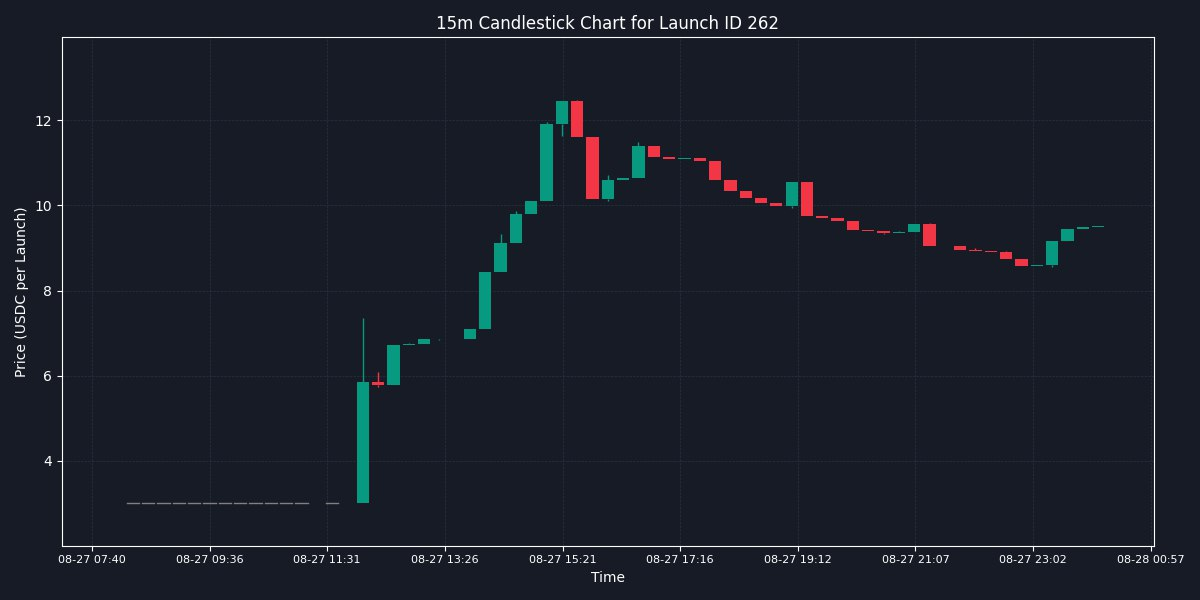
Hyperliquid’s approach was particularly notable due to the scale and impact of its point program. Over a 12-month period, the project distributed 310 million $HYPE tokens—31% of its total 1 billion token supply—to its community. This allocation significantly exceeded the typical 5% to 15% range seen in other airdrops, demonstrating the project’s commitment to rewarding its users. With the price of $HYPE increasing to $6.16 shortly after TGE, Hyperliquid’s airdrop became the most valuable ever at ~$2 billion, setting a benchmark for future point-based reward programs.
In recent months, the use of point programs by protocols to attract users has become widespread. However, for most of the other protocols, this strategy resulted in only short-term gains. After an initial spike in activity from users farming points, the conclusion of these programs often led to a significant drop in activity, as users moved on to farm points elsewhere. Hence, it is worth noting that point systems alone are not a guarantee of success; they must be paired with a great product and thoughtful execution to achieve sustainable growth and user retention.
Secondary Markets: Solving Points Illiquidity
Initially, Web3 points were illiquid, making it difficult to assign them a fair value. Without a mechanism for trading or price discovery, point holders had limited options to realize their value or manage their exposure effectively. In particular, large point earners can feel constrained by the inability to lock in profits before an airdrop, leading to frustration and dissatisfaction. At the same time, smaller point earners face barriers to competing in the point accumulation process, leaving them feeling excluded and disincentivized. For example, some of them might feel like they are late to the opportunity, and might be willing to pay a premium to catch up and make up for their tardiness.
To address this challenge, secondary markets like Whales Market were developed. These platforms act like OTC markets that allow users to trade points before they are officially converted into tokens, establishing a liquid market and enabling price discovery. By creating a space where points can be bought and sold, these markets provide a clearer sense of their value, effectively acting as prediction markets. Therefore, by allowing participants to express their opinions on a protocol’s worth, they offer a framework for estimating the value of a new token before it goes live.
The emergence of these secondary markets has introduced several advantages. For one, they provide liquidity, enabling users—particularly point farmers—to manage their risk by selling all or part of their holdings. This helps mitigate exposure to projects where users might otherwise feel “locked in” until an official token launch or airdrop. Furthermore, secondary markets may facilitate, at least in theory, a smoother transition into mainstream token trading by reducing volatility at launch, as prices are somewhat established in advance.
However, the speculative nature of these markets can also lead to unintended consequences that undermine the intended benefits. In fact, the valuation of points in secondary markets can lead to inflated prices driven more by sentiment than by a project’s fundamental value. Additionally, illiquidity in smaller markets can create execution inefficiencies, leaving prices vulnerable to manipulation. This speculative nature sometimes results in unsustainable valuations that can collapse upon token launch, leading to sharp sell-offs and price instability. One example is Portal, whose tokens were valued at $3 each on Whales prior to their listing. However, since going live, the token’s price has steadily declined, currently trading at $0.26—a drop of 91%.
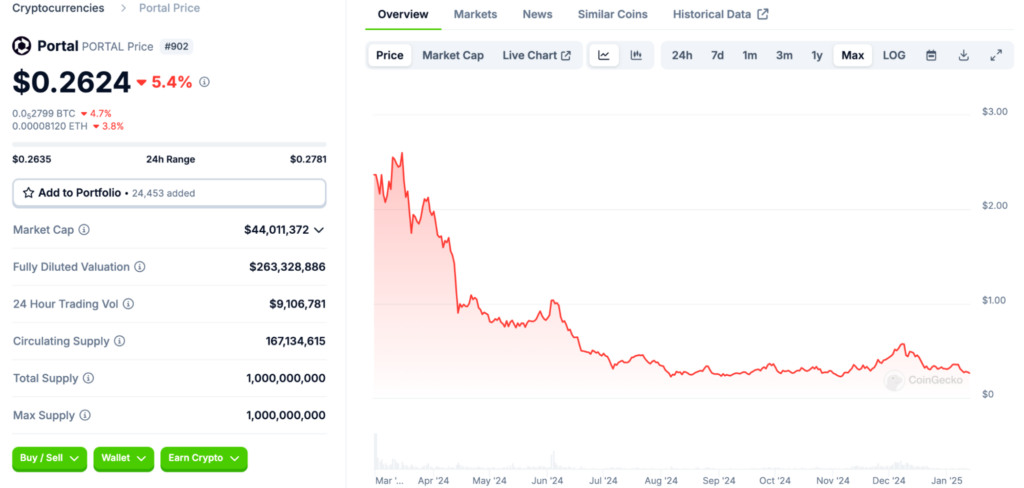
Point Systems Risks
As discussed so far, while point systems offer significant benefits, they can also introduce unintended consequences. A key concern is the dependency on user trust and the speculative nature of point valuations, which can incentivize predatory practices. In some cases, projects exploit users’ time and resources to inflate metrics like TVL or transaction volumes, prioritizing short-term gains over sustainable growth. This is vulgarly known as “protocols farming their users”. This dynamic often results in users focusing on maximizing immediate rewards rather than engaging with the project in a way that aligns with its long-term success. In other words, this attracts “mercenary farmers” seeking to extract as much value from the protocol as possible to then move on to greener pastures as soon as the incentives dry out.
Further complicating matters, some projects manipulate the rules governing point systems, creating an uneven power dynamic that disadvantages users. Teams may fail to provide transparency regarding reward distribution, omit fixed TGE dates, or extend point-earning campaigns across successive seasons without clear communication. These practices can frustrate users, erode trust, and diminish the perceived value of the points being accumulated.
Ultimately, while point systems have the potential to convert short-term participants into loyal users, their success depends on fair implementation, transparency, and a commitment to aligning incentives with the project’s long-term goals.
Introduction to Rumpel
Launched in mid-September 2024, Rumpel is a point tokenization protocol designed to enable secondary market liquidity and price discovery for off-chain loyalty points. The motivation behind Rumpel is twofold. First, it seeks to create a better experience for all stakeholders involved in point systems. Second, it aims to address the limitations of existing secondary markets while providing a robust infrastructure for trading points on-chain. Thus, by tokenizing points and allowing them to be easily traded on-chain with anything else and without principal risk, Rumpel introduces a flexible system to meet the needs of point farmers, investors, liquidity providers (LPs), and issuers while addressing the limitations of existing platforms.
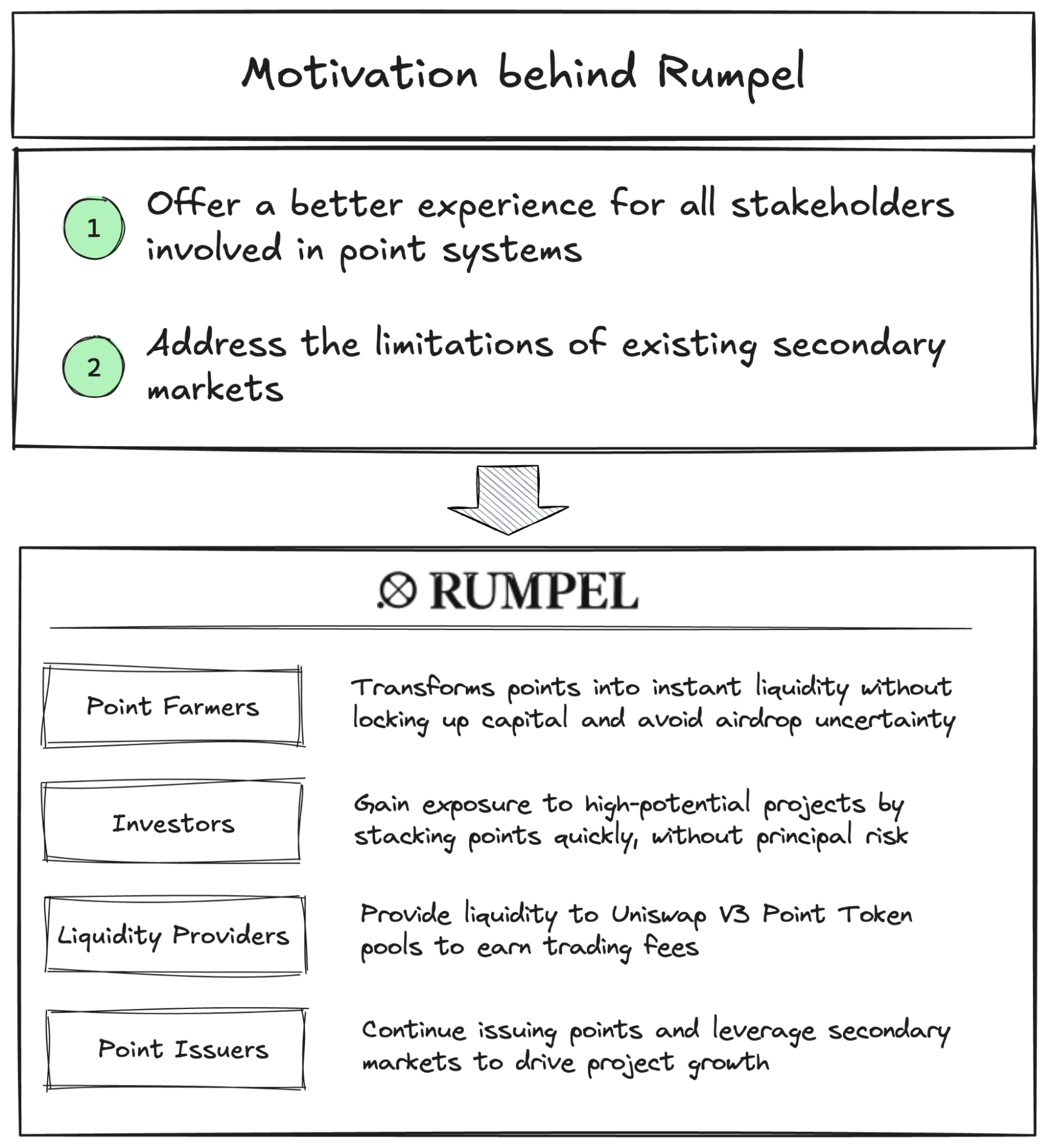
Point systems in Web3 often fail to meet user expectations, and as the ecosystem progresses, the limitations of traditional point systems—such as lack of transparency, liquidity constraints, and centralized control—have become more apparent.
Point farmers, who invest significant time and resources, face uncertainty due to unpredictable airdrop criteria and unknown allocations until after TGE. Point investors struggle to gain meaningful exposure, as large holders dominate point stacking, and many smaller participants feel excluded or overwhelmed by the effort required to compete. Additionally, point issuers face challenges in effectively leveraging point systems to incentivize growth when users become disengaged or apathetic.
Rumpel was created to address these issues by providing a platform where farmers can de-risk through point sales, investors can adjust their exposure, and issuers can deliver rewards with improved transparency and flexibility.
While secondary markets for points already existed prior to Rumpel’s inception, such as Whales and Bubbly, their solutions impose limitations that restrict their effectiveness. Many of these platforms require additional collateral from sellers, cap payouts for buyers, or prevent point holders from reselling earned points. Others lack the flexibility to trade individual point exposures, limiting user preferences and reducing market efficiency.
Rumpel’s founders recognized these gaps and saw an opportunity to build a secondary marketplace to solve these structural barriers and expand access to the benefits of point tokenization.
Understanding Rumpel’s Mechanism
Rumpel introduces a process for transforming off-chain loyalty points into on-chain assets through its tokenization protocol. Central to this system is the Rumpel Wallet, a specialized Safe multisignature wallet that allows users to wrap their earned loyalty points into Rumpel Point Tokens (pTokens).
The mechanism begins as users accumulate points through their participation in various loyalty programs. The Rumpel Oracle plays a critical role by validating off-chain point balances and updating users’ allowances for minting pTokens. This ensures that the tokenization process is accurate and aligned with users’ actual point holdings. Once tokenized and brought on-chain, pTokens can be traded, sold, or held in anticipation of future airdrop distributions.
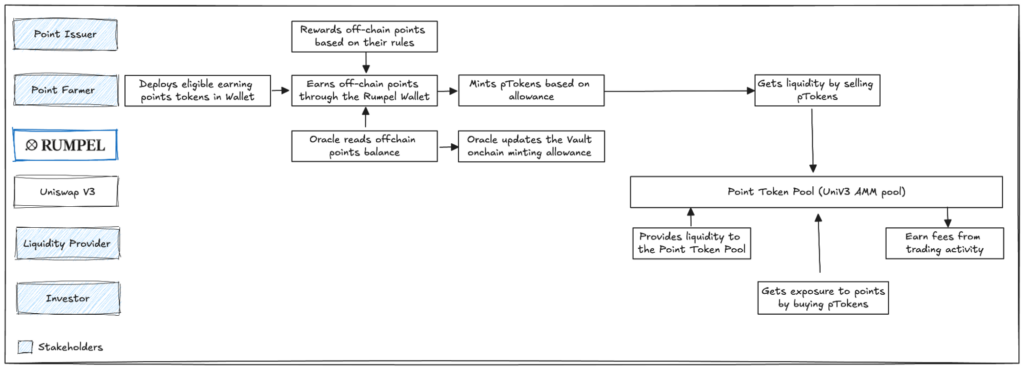
A key feature of Rumpel’s system is its ability to seamlessly integrate with airdrop events. When a project announces an airdrop, users holding pTokens can redeem them for their proportional share of the airdrop rewards, including any vesting allocations. This provides a direct and efficient pathway for point holders to access their rewards without the uncertainty and delays typically associated with off-chain point systems.
Rumpel Wallet
The Rumpel Wallet offers users a personalized and secure way for earning, managing, and tokenizing loyalty points. Built on “Safe’s Module Framework”, the wallet is enhanced with the Rumpel Guard and Rumpel Module. Users accumulate points directly in their wallets through whitelisted strategies, with balances validated by the Rumpel Oracle. Once the Oracle confirms the off-chain point balances, it updates the minting allowances, enabling users to mint pTokens against their accumulated points and trade them on secondary markets.
The Rumpel Guard’s role is to maintain the integrity of the system by preventing users from claiming rewards for points they have already tokenized and sold. This is achieved by restricting all actions to those explicitly whitelisted, ensuring users can only perform permitted operations within the wallet. The Guard is managed by an admin, who maintains a list of authorized actions, such as specific function calls or transfers. Certain actions, like USDC.transfer, can be permanently allowed to guarantee users retain access to essential wallet functions, providing a layer of predictability and transparency.
The Rumpel Module complements the wallet’s functionality by automating reward management on behalf of users. When an external protocol releases reward tokens, the Module enables the admin to claim them and transfer them directly to the Rumpel Vault for Point Token redemption. This process is typically executed atomically to minimize risks, ensuring that reward tokens do not remain idle in the user’s wallet. Additionally, the Module features an irreversible blocklist that restricts unauthorized actions, reinforcing the wallet’s security and providing users with confidence that their assets are safeguarded.
By combining the Rumpel Guard and Module, the wallet strikes a balance between user control and systemic oversight. Users can manage their points with flexibility and ease, while the wallet’s security features protect the value and legitimacy of tokenized points.
Rumpel Oracle
The Rumpel Oracle functions as an off-chain system responsible for verifying point balances accumulated in Rumpel Wallets. Its primary role is to ensure accuracy and consistency in updating the minting and redemption allowances for pTokens within the Rumpel Vault. By validating off-chain data and converting it into actionable updates, the Oracle bridges the gap between off-chain loyalty points and their on-chain representations.
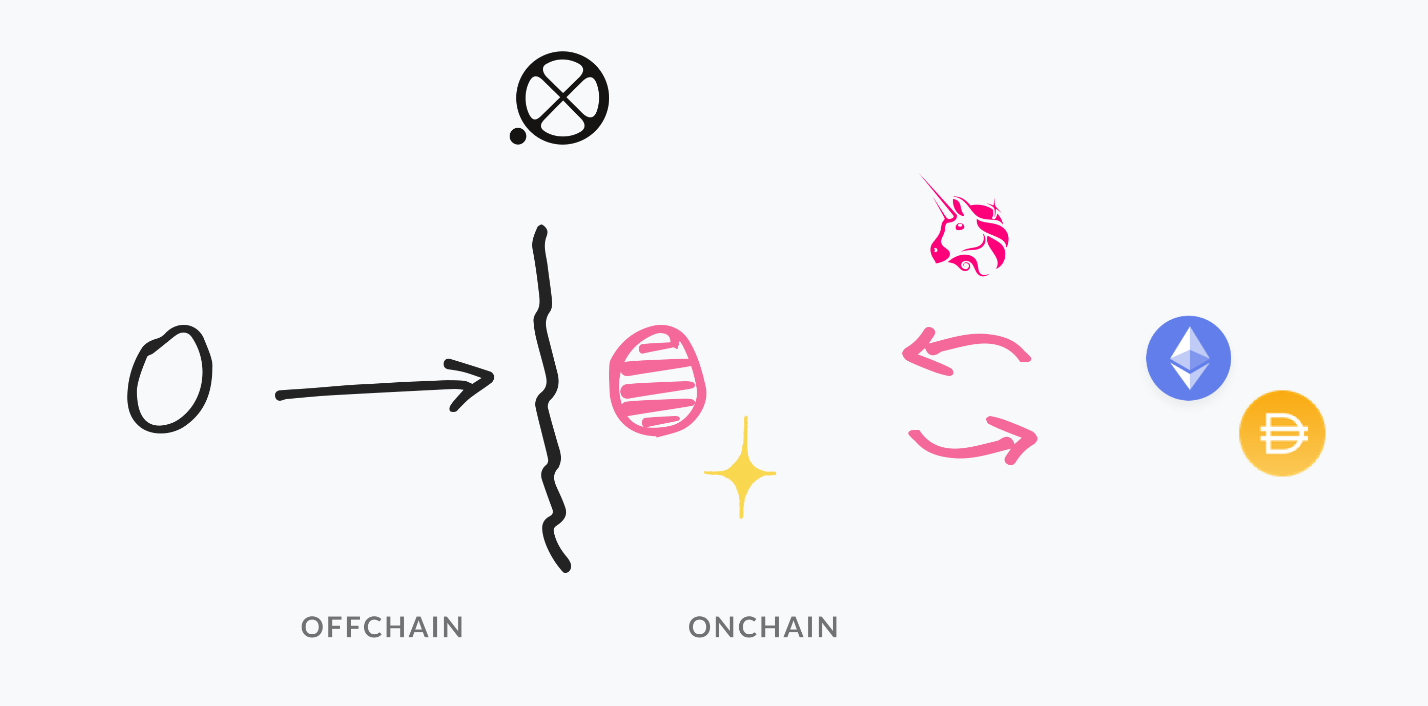
To minimize errors and maintain system integrity, the Rumpel Oracle disseminates pToken minting allowances through a Merkle root every three to five days. This deliberate delay of more than three days serves as a safeguard, allowing time to identify and mitigate any potential discrepancies in the data.
The Rumpel protocol further improves the reliability of its Oracle system by operating multiple distinct Oracle clients. This diversification reduces the risks associated with any single point of failure and ensures that the overall system remains robust even if one client encounters issues. Additionally, Rumpel plans to progressively decentralize the Oracle component, with the goal of further strengthening its security and trustworthiness over time.
Rumpel Vault
The Rumpel Vault is a smart contract that serves as the operational hub for managing all activities related to the minting and burning of pTokens. It works in close coordination with the Rumpel Oracle, which provides continuous updates regarding minting allowances and redemption details. This dynamic interaction ensures that the Vault remains in sync with the point balances and reward mechanisms.
When a point-issuing project announces an airdrop, the Rumpel Oracle updates the redemption logic within the Vault to reflect the new conditions. At this stage, Rumpel acts on behalf of users to claim all eligible reward tokens from the issuing project and securely transfers them into the Vault. Importantly, this process is designed to avoid interfering with users’ capital at any time, preserving the security and trustworthiness of the system.
Once the rewards are secured in the Vault, pToken holders can redeem their tokens for the underlying reward assets. The redemption process is flexible and adheres to the specific terms set by the project, accommodating vesting schedules or other conditions as necessary. This ensures that users receive their rewards in alignment with the original point program’s structure while maintaining the integrity of their pTokens as fully backed assets.
Rumpel Point Tokens: pTokens
Rumpel Point Tokens, or pTokens, are digital assets that represent off-chain loyalty points and their associated future rewards. These tokens map directly to the points accumulated by users through their Rumpel Wallets, maintaining a standardized ratio of either 1:1 or 1:1000 (kilo) with the original points. As standard ERC20 tokens, pTokens adhere to widely accepted blockchain protocols, enabling seamless integration with existing DeFi platforms.
The lifecycle of a pToken begins when a user earns loyalty points through their Rumpel Wallet. As the Rumpel Oracle validates the user’s off-chain point balance and updates their minting allowance, the user can mint pTokens against their accumulated points. pTokens can then be traded on DEXes like Uniswap v3. For example, a user might choose to sell his pTokens for $ETH or $DAI, hence reducing his exposure to the uncertainty of future airdrops. On the other side, buyers can purchase these tokens to gain exposure to specific loyalty point programs without meeting the same capital or effort requirements. This two-sided market creates liquidity and fair pricing for loyalty points.
Eventually, when a project announces an airdrop, pToken holders can redeem their tokens for a proportional share of the reward tokens through the Rumpel Vault. For reward distributions involving vesting schedules, Rumpel provides special Redemption Rights to ensure that pTokens remain fully backed throughout the vesting period. This mechanism safeguards the value of pTokens and ensures that holders retain access to their rewards over time.
Benefits to Stakeholders
Rumpel aims to address the specific needs of the following key stakeholders: (1) point farmers, (2) point investors, (3) liquidity providers (LPs), and (4) point issuers.
For point farmers, Rumpel offers a solution to one of their biggest challenges, liquidity, by allowing them to tokenize their accumulated points and sell them on secondary markets.
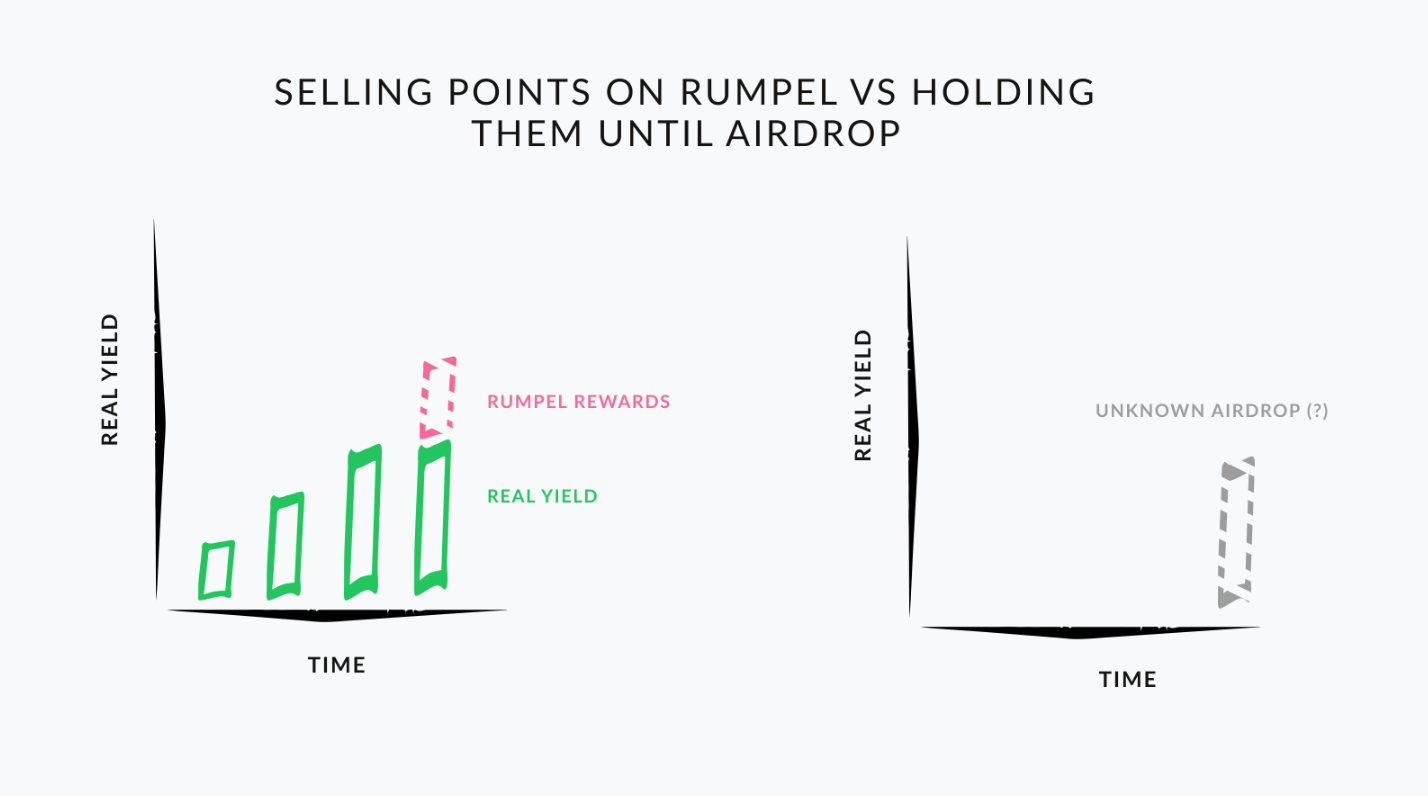
This process allows point farmers to de-risk specific point exposures and realize a competitive market price for their points before an airdrop. Beyond liquidating points, farmers retain control of illiquid points and earn Rumpel Straw, further diversifying their yield opportunities.
Point investors benefit from Rumpel by gaining streamlined access to directional exposure in point programs without committing significant capital or exposing their principal to complex smart contract risks. When the point issuer announces an airdrop, point investors will be entitled to a proportional share of the reward tokens, which they can redeem through the Rumpel Vault. This system enables investors to bet on high-quality projects with anticipated rewards while bypassing many of the operational hurdles typical of early participation. However, investors must be aware of risks such as point token price volatility and potential mismatches between token redemption values and airdrop rewards.
LPs can add liquidity to designated pools on Uniswap through the Rumpel Portal, earning trading fees from point token price fluctuations. The system accommodates both passive buyers providing bid-side liquidity and passive sellers offering ask-side liquidity. However, LPs must weigh the potential for impermanent loss caused by unexpected point token volatility.
For point issuers, the value proposition of Rumpel is to improve the effectiveness and visibility of their point programs by leveraging secondary markets. Speculative trading of point tokens increases user-generated content and visibility for the project. Additionally, by serving both risk-averse users who sell and loyal users who buy, issuers can cater to a broader audience, improving user conversion and improving metrics like transaction volume and retention. To integrate with Rumpel effectively, issuers must meet certain technical requirements, including on-chain airdrop mechanisms and public API access for point balances, thus ensuring seamless integration with the protocol.
Differentiation From Competitors
While the emergence of protocols like Whales Market, Bubbly, Pendle, Pichi, and others demonstrates the growing demand for on-chain points markets, these platforms often fail to meet the diverse needs of point farmers, investors, and issuers.
Whales Market, as an early pioneer in points trading, introduced a decentralized OTC platform for exchanging assets across blockchains. However, it requires point sellers to provide collateral, and settlements occur only after the TGE. These constraints delay liquidity and increase barriers for users seeking immediate access to funds.
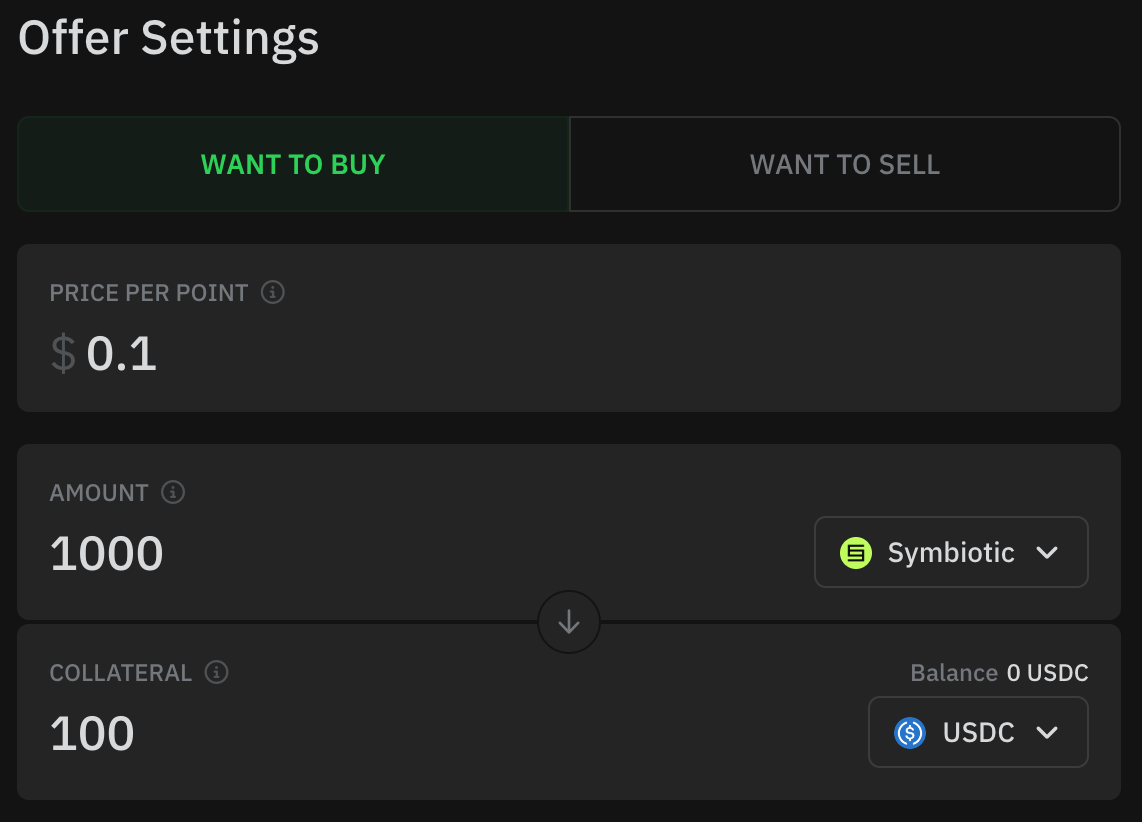
Similarly, Bubbly employs an AMM-based model with liquidity pools but imposes collateral requirements on point sellers. In particular, the seller needs to pre-deposit collateral to sell points. Then, when the seller delivers the corresponding spot for the points, they will receive twice the collateral; otherwise, they will lose the collateral.
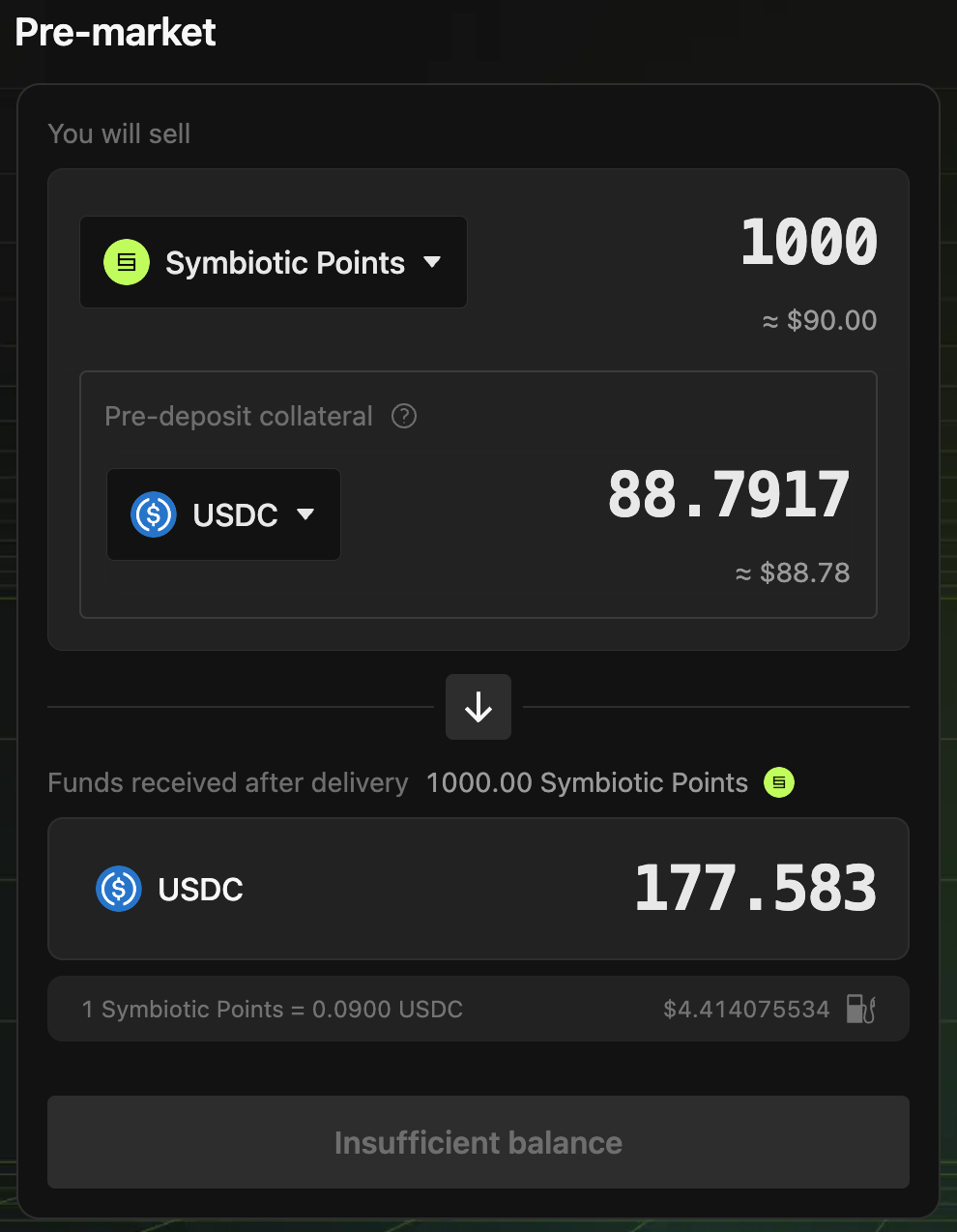
While these platforms solve some aspects of point trading, their reliance on collateral limits participation and reduces accessibility for users. In other words, the requirement to escrow funds for long periods of time increases the opportunity costs for market participants, resulting in capital inefficiency.
Fixed-rate protocols like Pendle, Spectra, and Hourglass allow users to gain leveraged exposure to points, but lack flexibility. These platforms were designed for interest rate derivatives trading, not as points marketplaces. For instance, Yield Token (YT) holders cannot resell earned points, and sellers face liquidity constraints if they attempt to withdraw early. This approach restricts users who require immediate liquidity or wish to fine-tune their exposure. Others like Pichi use an ERC-6551 token-bound account model through Michi Wallet NFTs. While it eliminates collateral requirements, it is not optimized for trading individual point exposures, making it less suitable for users who prioritize granular control or prefer liquid trading options.
Rumpel differentiates itself by eliminating these constraints: collateral-based systems, inflexible redemption structures, and illiquid trading models. Through the Rumpel Wallet, users can tokenize their points into pTokens without needing collateral, and these tokens are tradable on a single Uniswap v3 pool. Unlike competing alternative solutions, Rumpel supports all types of points, enabling users to manage their exposure to any program. Additionally, point buyers can gain uncapped upside, as they can fully capture a point’s potential airdrop payout without restrictions.
Rumpel App: Overview and Case Study
On launch, Rumpel partnered with protocols like Ethena, Symbiotic, Zircuit, and Karak, offering users opportunities to tokenize and trade points tied to these programs. The platform has since expanded its ecosystem, adding support for protocols like Mellow and EtherFi.
Overview
Since its launch on September 24, as of January 2025 Rumpel has achieved a TVL of more than $50 million and a total point token market cap of $424k.

This growth has been further supported by Rumpel’s native point program, Rumpel Straw. Rumpel Straw serves as both an incentive mechanism and a community-building tool, encouraging early adoption and sustained usage. The Straw story unfolds in themed phases known as “Chapters”, each designed to reward specific activities and increase the ecosystem growth. Chapter 1 concluded on December 1, 2024, laying the foundation for the platform’s initial user base. Chapter 2, which runs from December 1, 2024, to March 1, 2025, introduces a Continuous Emissions model. This model distributes Straw daily, based on user activity across strategies, the dollar value of their participation, and the duration of their engagement.
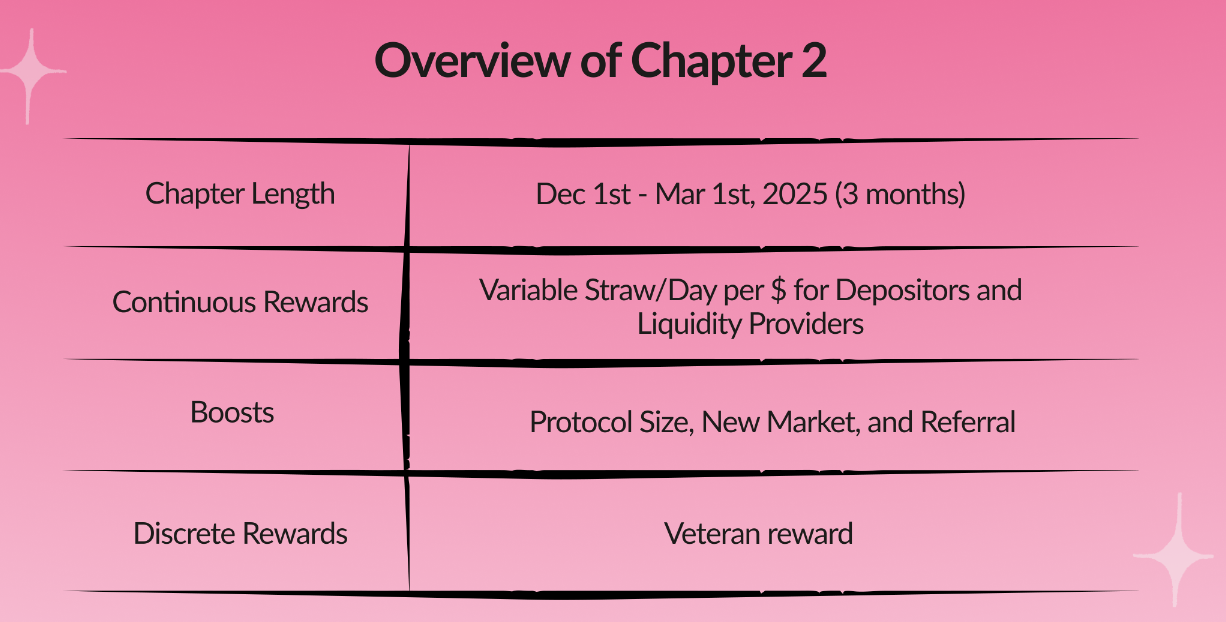
Case Study: Running a Strategy on Rumpel
To begin using Rumpel, the first step after connecting your Ethereum wallet is to create a Rumpel Wallet.
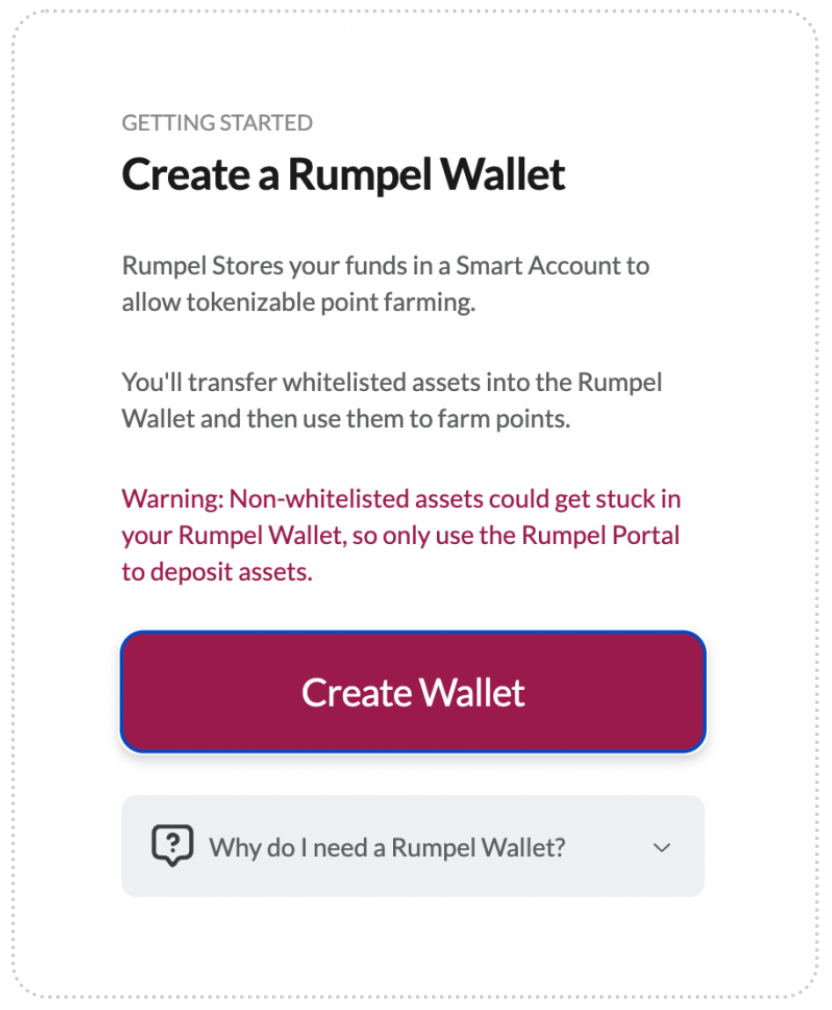
Having created a wallet, users can now explore the platform’s “Earn” Dashboard, which offers more than 30 strategies to accrue points directly into their Rumpel Wallets. These points can be tokenized into Rumpel pTokens and traded on Uniswap v3, enabling users to unlock liquidity and participate in secondary markets.
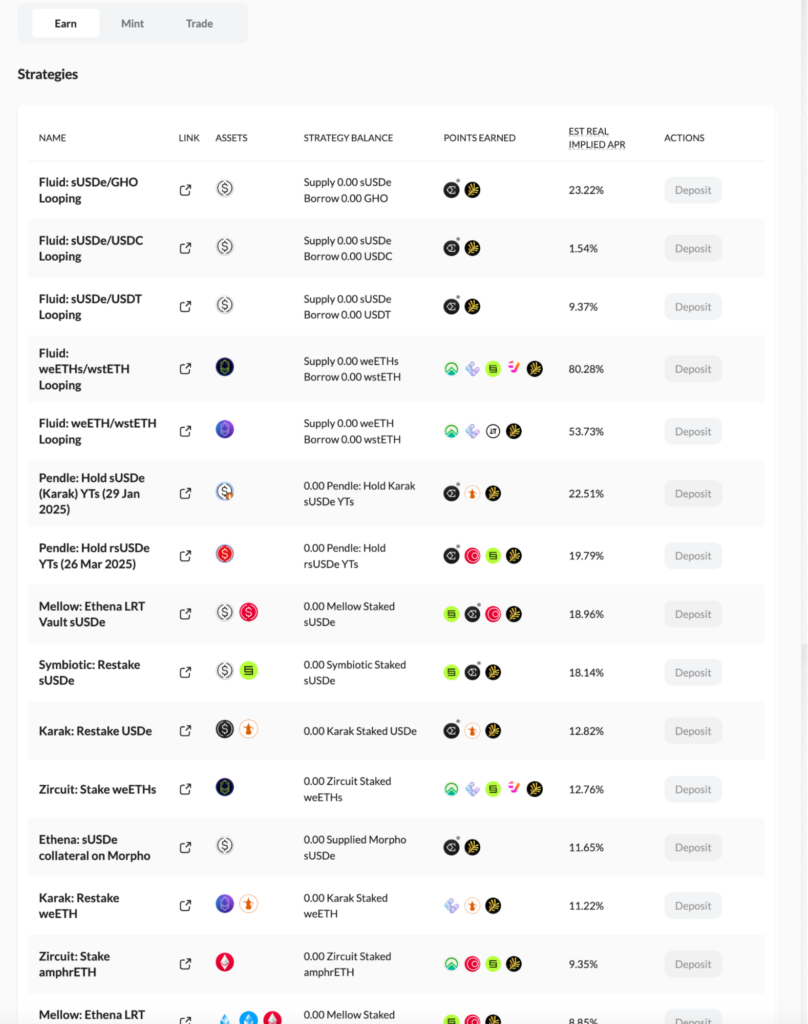
To illustrate how to use Rumpel after implementing one of the available strategies, let’s consider the first strategy listed in the “Earn” Dashboard: “Fluid: sUSDe/GHO Looping”. Suppose you already have sUSDe in your wallet. You can navigate to Fluid and open a position by lending sUSDe and borrowing GHO. This action sets up the looping position, as depicted in the image below.
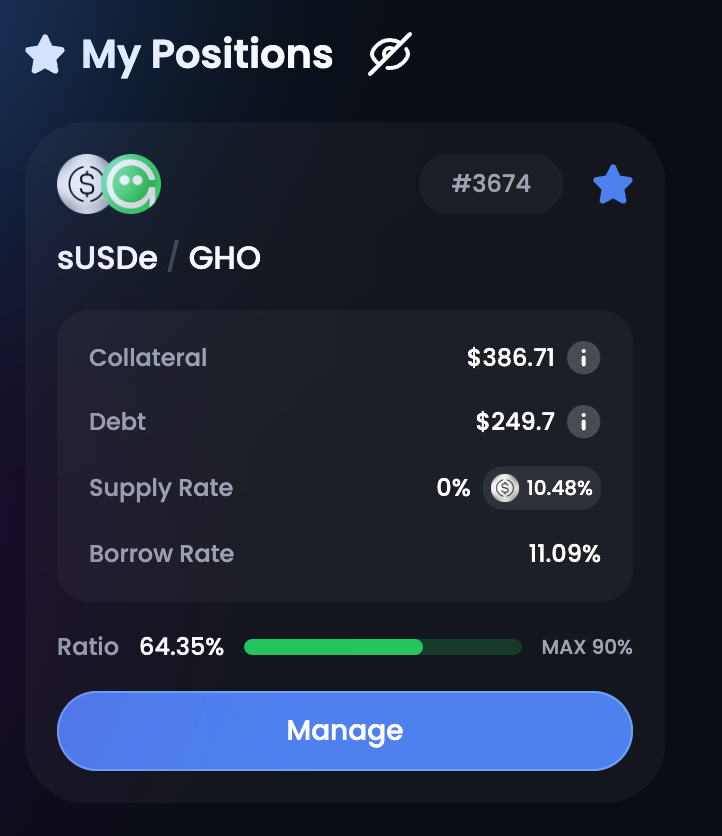
Once the position is open, the “Migrate” button under the “Actions” column will become enabled, indicating that you can now transfer your position NFT into your Rumpel Wallet.

A summary of the position will be displayed for your review, and with just one click the migration progress will be completed.
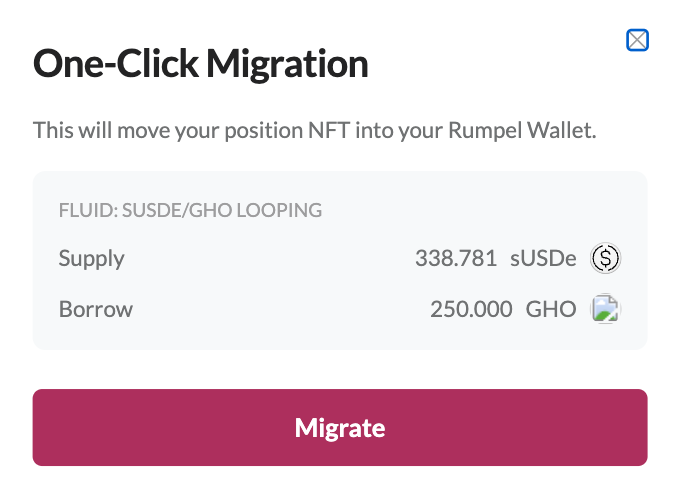
Finally, under the list of Strategies, you will see that the procedure has been successfully completed, with your position now displayed as being in the “Earning” status.

The Estimated Real Implied APR provides an estimate of the yield earned on the underlying asset by minting and selling all liquid point exposure at current market prices.
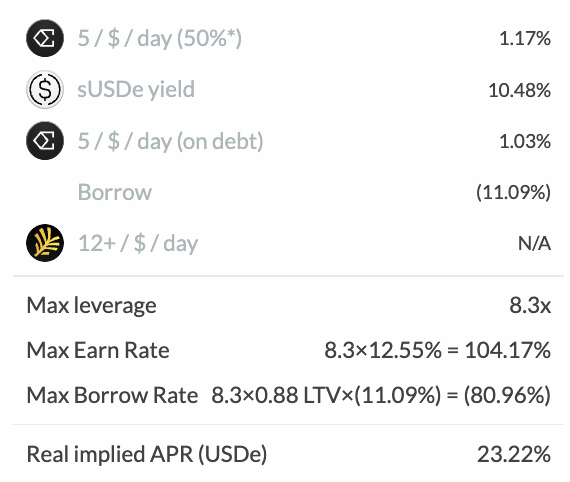
After depositing the underlying asset into the Rumpel Wallet or migrating one of the available strategies to it, points associated with the underlying asset will begin accruing under the “Mint” Dashboard. These points will then become available for minting as pTokens.

After minting pTokens, if you wish to de-risk your point exposure and monetize them, simply navigate to the “Trade” Dashboard. There, you can view the available balance of points ready to be traded on Uniswap v3.
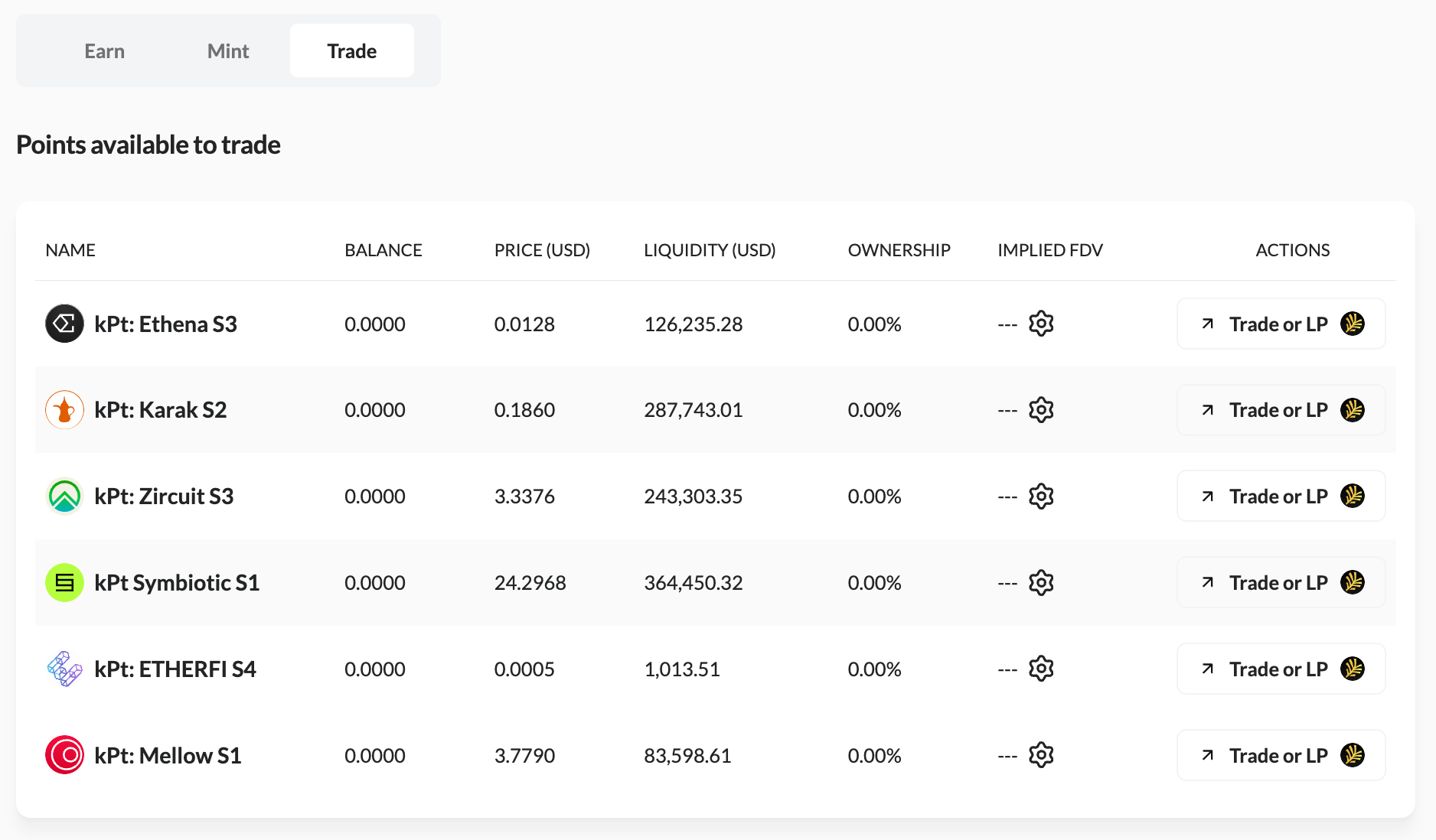
For example, in our use case where sUSDe was used as the underlying asset, the points available for trade would be “kPt: Ethena S3”. At the time of writing, these points are tradable at a market price of $70.
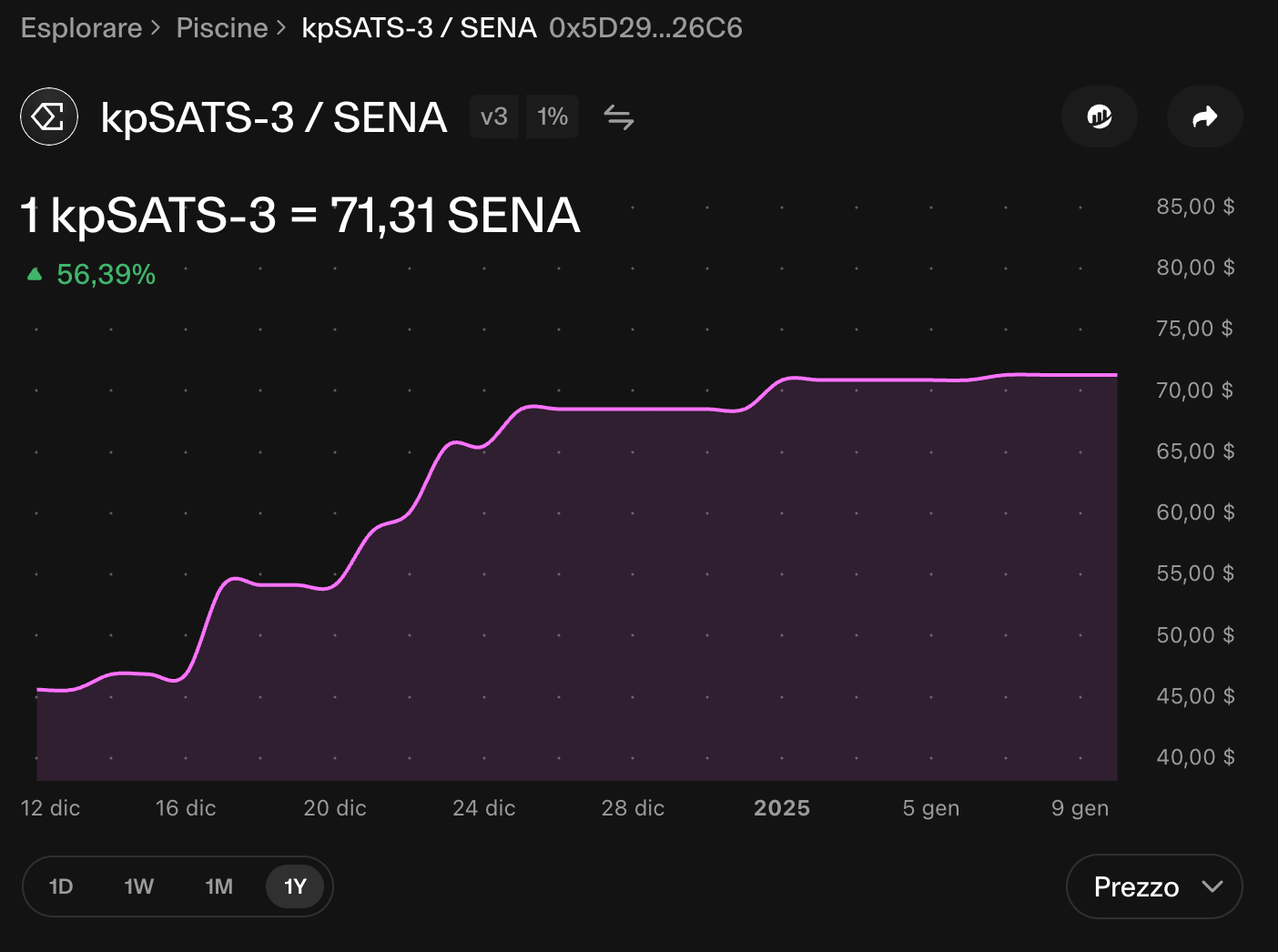
The use case we just illustrated was from the perspective of a point farmer looking to de-risk their exposure to points. However, if you have a positive outlook on a particular point system from a specific protocol and want to increase your exposure, the process is much simpler. You can directly purchase additional points through the corresponding Uniswap pool. Similarly, you can also participate as a LP, contributing liquidity to designated Uniswap V3 Point Token pools. This allows you to earn trading fees while also accumulating Rumpel Straw as an additional reward.
Conclusion
Point systems have become an important tool in the Web3 ecosystem, driving user engagement and shaping behavior through new reward mechanisms. Once limited to traditional loyalty programs, these systems have evolved to meet the demands of decentralized platforms, offering a way to incentivize participation and build early traction. Lately, an ever growing number of projects started adopting point systems to bootstrap liquidity and increase user loyalty.
Launched in mid-September 2024, Rumpel is a point tokenization protocol designed to enable secondary market liquidity and price discovery for off-chain loyalty points. Its primary goals are to create a better experience for stakeholders such as point farmers, investors, liquidity providers, and issuers, and to address the limitations of existing secondary markets–collateral-based systems, inflexible redemption structures, and illiquid trading models.
By tokenizing points and providing a transparent, on-chain marketplace, Rumpel allows users to manage their exposure efficiently while offering projects a way to increase the value of their rewards programs.
References
Introducing Rumpel: Turning Points into Profit. Rumpel Labs | Link
Pointenomics 101: Mastering the New Language of Crypto Incentives | Link
Point Systems Perspective. Alea Research | Link
Rumpel Documentation | Link
Rumpel Project Deep Dive | Link
Rumpel Straw Program Chapter 2 | Link
Rumpel Website | Link
Disclosures
Alea Research is engaged in a commercial relationship with Rumpel as part of an educational initiative and this report was commissioned as part of that engagement.
Members of the Alea Research team, including those directly involved in the analysis above, may have positions in the tokens discussed.
This content is provided for educational purposes only and does not constitute financial or investment advice. You should do your own research and only invest what you can afford to lose. Alea Research is a research platform and not an investment or financial advisor.

